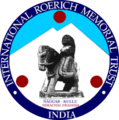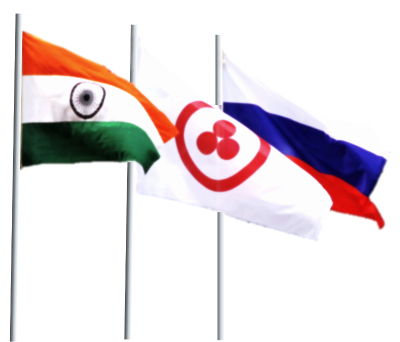Revival of "Urusvati" Himalayan Research Institute
Revival of “Urusvati” Himalayan Research Institute which was quite active in early and mid 1930s but had to suspend its activities due to the outset of the war with Nazi Germany, was a major concern for Svetoslav Roerich. Quoting the words of Svetoslav Roerich, Mrs. Lyudmila Shaposhnikova writes, “...The Institute is not just another scientific institution. The future of science is contained in it. Back then, during the war and afterwards the existence of the Institute was not easy. The research and the method developed there were suspended. It was not us, the Roerichs, who developed it, but our Master who created the Living Ethics and whose plans we were implementing. You see, it was all well-conceived and even better implemented. The work we were doing contained in itself not only the future of new science but also the future of mankind’s evolution, its transfiguration and the new forms of its existence.” (Lyudmila Shaposhnikova. Light of the Morning Star)
Svetoslav Roerich consistently believed that revival of the Institute and a key to its successful functioning are inseparably connected with the cooperation between India and Russia. In his letter to the then President of the Russian Federation Boris Yeltsin, the artist wrote: “I am convinced that the activities of the Centre, which is one of the founders of the International Roerich Memorial Trust known to you, will for many years benefit the cultures of Russia and India.” Therefore, setting up the International Centre of the Roerichs, Moscow (1989) and the International Roerich Memorial Trust in Naggar (1992-93) Svetoslav Roerich implied their close cooperation and collective work, including in the task of revival of “Urusvati” Institute.
At present, the IRMT and the ICR are developing the concept of the revival of “Urusvati” Institute in accordance with the will of Svetoslav Roerich, who believed that the revived Institute should become a modern international research center and at the same time develop the research initiated by the Roerichs.
The revival of the Institute is supposed to proceed in two directions: memorial and museum-related, and academic research-related.
Old exhibitions are being updated and new ones opened in the Administrative and Laboratory Blocks of the Institute. There are plans to display all permanent exhibitions on the history of the Institute and its activities in the Administrative Block, which used to house its main departments, research library and museum. On the 1st floor of the same building the Memorial Study of George Roerich, the director of “Urusvati” Institute will be open to visitors.
In the Laboratory Block of the Institute the permanent exhibition “The Roerich Pact: History and Modernity” opened in 2014. In the same block a new permanent exhibition of the Himalayan folk art was inaugurated in October 2015. On the 1st floor there is a depository of contemporary art works owned by the IRMT. In the Chemical Conservation Laboratory on the ground floor conservation and restoration of museum items and printed editions is done.
The research work in the Institute started several years ago when on a referral of the International Centre of the Roerichs, Moscow, several experts arrived to study the surviving zoological and botanical collections of the Institute. A.A.Lisovsky, Research Fellow with the Zoology Museum, Moscow State University named after Mikhail Lomonosov, worked with the zoological samples, while Senior Research Fellows of the Main Botanical Garden of the Russian Academy of Sciences S.A.Potapova and Doctor of Biology V.G.Shatko studied the herbariums.
In 2012-13 the ICR staff located, described and registered the books from the “Urusvati” Institute Research Library housed in two halls of the Laboratory Block of the Institute.
In October 2014 during the celebrations of Nicholas Roerich’s anniversary the IRMT in cooperation with the ICR hosted the international academic seminar on the “Creative Heritage of the Roerichs and its Significance for the Cultural Development of Mankind.” A.A.Lebedenko, Deputy Head of the United Scientific Center for Cosmic Thinking Problems, Moscow, A.G.Palkin, Research Fellow with the Steppe Institute, The Ural Branch of the Russian Academy of Sciences, Orenburg, Russia, Tsering Dorje, a Buddhist scholar from Lahaul, India, who authored a number of academic works on Buddhism, linguistics and the culture of Himachal Pradesh, the British artist and writer Carol Fraser and the artist Atma Ram Koigade, Maharashtra, India took part in its deliberations.
On the anniversary of George Roerich on August 16, 2015 the IRMT organized an academic seminar “George Roerich, the Eminent Explorer of Asia.” A Buddhist scholar, linguist and writer Tsering Dorje presented a paper on “George Roerich’s Contribution to the Archeological Excavations of Lahaul.” The ICR and IRMT employee Sanskritist Alexander Pereverzev spoke on the milestones of George Roerich’s life and career. Dr. Petr Abramov, ICR, Moscow, presented a paper on the “Research of Consciousness in Buddhism and Neuropsychology.”
In order to restart research work and attract scholars the IRMT plans to conduct regular academic seminars and conferences. It is also working to provide accommodation and working facilities to visiting scholars and researchers to enable the prospective fellows of “Urusvati” Institute to come to the Himalayan Roerich Estate to do their research. The work of studying and systematizing the collections of the Institute library is also under way. One can state with certainty that due to the joint effort of Russia and India the revival of “Urusvati” Institute that Svetoslav Roerich dreamt of is slowly but steadily becoming a reality.










